If global elites have their way, 2021 will be the year of the “Great Reset.”
They believe now, after the coronavirus and lockdown policies have inflicted a heavy toll on the public, is the perfect opportunity to implement their technocratic vision.
 Their longstanding plans to transform economies in the name of various “sustainability” and “equity” goals are being aggressively implemented.
Their longstanding plans to transform economies in the name of various “sustainability” and “equity” goals are being aggressively implemented.
World Economic Forum chairman Klaus Schwab vows, "a renewed focus on public health and resilience, net-zero pledges and the arrival of Stakeholder Capitalism Metrics—all but ensure that 2021 will be a new 'Year Zero.'"
The reset that is coming may not necessarily be the one that globalist central planners are trying to impose, however.
Markets have their own way of resetting according to economic, political, and monetary realities.
The Federal Reserve is currently embarked on a campaign to raise the inflation rate. Jerome Powell and company imagine they can engineer a gentle increase in price levels without causing any disruptions, then push back down on inflation before it becomes a serious problem.
What could go wrong? Given that the stock and bond markets are priced for low inflation, the entire financial system could have go through a great (and painful) repricing to reflect accelerating currency depreciation.
The U.S. dollar may fail to rally under conditions that would have signaled tighter monetary policy in previous eras, begetting even more inflation.
According to a recent Wall Street Journal commentary, “If markets take the Fed at its word, they won't bid up the dollar as they normally might in response to robust inflation or growth data out of the U.S. This is why TS Lombard economist Steven Blitz calls the new framework an effective end to the traditional ‘strong dollar’ policy of the U.S. government.”
Investors who have heavy exposure to the U.S. dollar via bonds, money market funds, and the like, may need to reset their portfolios before inflation wrecks their value.
Similarly, those who hold stocks because they believe “TINA” (there is no alternative) shouldn’t assume they will be the best alternative to bonds and cash going forward.
The ultimate alternative to a depreciating fiat currency that is being printed into oblivion is hard currency – gold and silver.
Precious metals investors can also benefit from reevaluating their assumptions, strategies, and holdings from time to time – and the New Year may be a good impetus.
Even if you had a successful year in the markets in 2020, you likely made some mistakes or missed some opportunities. (Don’t you wish you had bought more silver when it was trading under $15/oz last spring?)
Of course, in retrospect we’d all make genius investing moves. But the reality is that future market swings are inherently unpredictable in terms of their timing and magnitude.
In terms of fundamental value and long-term prospects for appreciation, investors can make decisions with much greater certainty.
A 30-year bond is currently priced to pay out a negative real yield (below the Fed’s own inflation objective) each of those 30 years. That’s slow-motion wealth destruction.
Over the next three decades, it’s possible for precious metals markets to go through cyclical downturns – some perhaps severe. But it’s also a virtual guarantee that gold and silver will ultimately rise as the value of the dollar “resets” lower.

